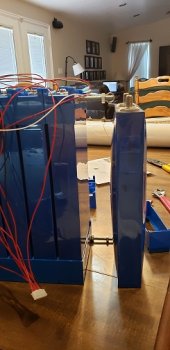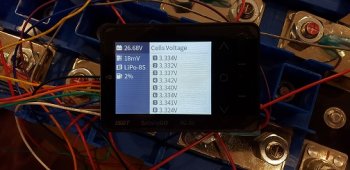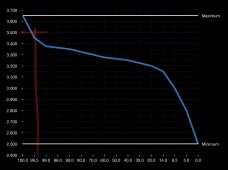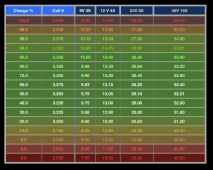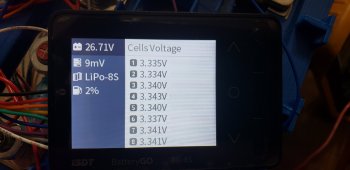Allgood-Energy
Prepare Yee Prepare Yee for End of Days
- Joined
- Sep 24, 2020
- Messages
- 48
I have an unusual problem with a fortune 100 Ah Cell from ElectricCarParts.com in SLC. I live in Utah and picked them up directly.
The End Cell on the Positive end Swelled UP and bulged Like it has been out gassing and the port is clogged or sealed. Lucky it has not exploded.
I bought the 8S cell set a year ago and balanced them then and topped them off 2 months a go and have not connected them up since, except to monitor the cell voltages and only to the voltage monitor. They have not been used at all except to top them off, once in a while. They have not been connected to a real load or charged above 29 Volts and 5 Amps.
I had the end cell swell up and bulge the other day. Very Strange to have a cell just expand like that. Here are the pictures of the Problem.
I have been wanting to connect them up to a 200 Amp BMS and inverter and MPPT solar control with 400 watts of solar. I have been busy with other things so these cells have been just sitting on my Desk with nothing connected except the monitor wires not even the voltage monitor display. I have been connecting the monitor display once in a while to see how much the voltage has dropped just sitting. The voltage has Not dropped much Just sitting.
Do You have any explanation?
Very Very Strange and troublesome.
Is It Safe to Keep this battery or is it a disaster waiting to happen?
Not Sure how many days this has been this way.
I just heard form Carl at ElectricCarParts.com and they are going to replace it, but they are currently out of stock for a couple of weeks.
The End Cell on the Positive end Swelled UP and bulged Like it has been out gassing and the port is clogged or sealed. Lucky it has not exploded.
I bought the 8S cell set a year ago and balanced them then and topped them off 2 months a go and have not connected them up since, except to monitor the cell voltages and only to the voltage monitor. They have not been used at all except to top them off, once in a while. They have not been connected to a real load or charged above 29 Volts and 5 Amps.
I had the end cell swell up and bulge the other day. Very Strange to have a cell just expand like that. Here are the pictures of the Problem.
I have been wanting to connect them up to a 200 Amp BMS and inverter and MPPT solar control with 400 watts of solar. I have been busy with other things so these cells have been just sitting on my Desk with nothing connected except the monitor wires not even the voltage monitor display. I have been connecting the monitor display once in a while to see how much the voltage has dropped just sitting. The voltage has Not dropped much Just sitting.
Do You have any explanation?
Very Very Strange and troublesome.
Is It Safe to Keep this battery or is it a disaster waiting to happen?
Not Sure how many days this has been this way.
I just heard form Carl at ElectricCarParts.com and they are going to replace it, but they are currently out of stock for a couple of weeks.




